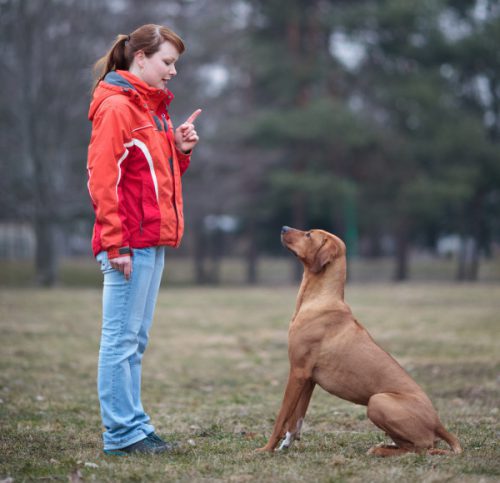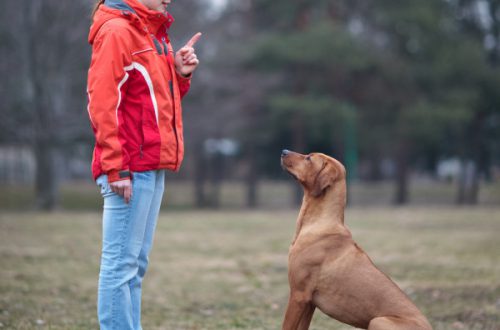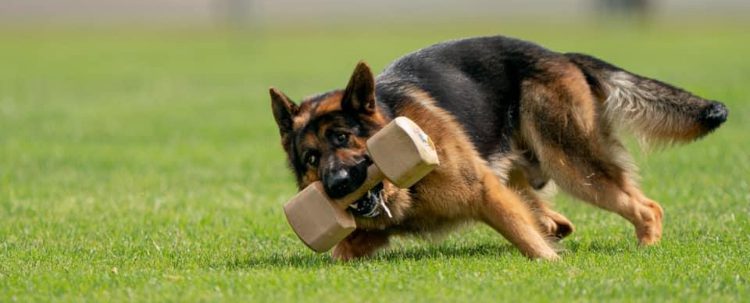-
Musical Treats
This game can incorporate the whole family. Each person has a ‘hidden’ treat in his or her hand. Everyone starts to run around and play, hooting and hollering so the dog doesn’t know whom to chase first. A designated person (whom the dog is not near) yells, “come”; at that time everyone freezes and waits for the dog to go to that person. Once the dog does respond to the come command, that person gives him a treat. Then someone else in the family calls the dog, he may not want to leave the person whom just treated him, just wait him out, repeat the command and when he comes…
-
Private Refresher Training
New training program Developed with you in mind! My private refresher training sessions—just one lesson per month—will help keep you and your dog on track and progressing smoothly. This is perfect for any person that wants to keep their dog moving in the right direction before problems begin to occur or need to teach their bored puppy something else but can’t commit to weekly lessons. Location: All classes are held in Denville NJCurriculum: We can work on new developing problems you are encountering or teach your dog more complicated skills to keep him/her mentally motivated. Cost: 6 lessons= $600 (all classes must be paid at first session) *all lessons must be completed…
-
The Power of Play
It is human nature to separate the ideas of work and play. Work imposes a schedule and deadlines. It might involve the hassles of getting to and from a specific place and interacting with others whose company we might not choose in social circumstances. For many people, “work” time is distinct from “fun” time. So unsurprisingly, many people extend that distinction to training or working their dogs. They view “training” time as something distinct from “play” time. It doesn’t have to be that way. Do What You Love There’s an old saying “Do what you love and you’ll never work a day in your life.” While that may not feel…
-
Crate Training
When determining if a dog was eligible to stay with me for Campus Training, I always ask if the dog is crate trained. A “crate-trained” dog will enter the crate when told, remain in the crate for reasonable periods of time without barking, scratching, or pawing, and exit the crate calmly. I am a trainer who loves crates! I love them because I know that my dog and my home are both safe when I’m out. Being free and alone in the house can be stressful for a dog—especially a dog or pup that is new to your home. Your dog’s attempts to alleviate his own stress can result…
-
Reliable Recall
The “recall,” the command that brings your dog to you, is extremely important for your sanity and your dog’s safety! Whether you need your dog to come in from the yard when you are running late for work or want to be able to hike off-leash—a good, reliable recall is vital. With a good recall, you can bring your dog to you quickly when time or safety are a factor. Without a good recall, you are at the mercy of your dog’s impulses. What is a reliable recall? A good reliable recall is when your dog responds to your recall command by returning to you immediately and without…
-
Dumbbell Retrieve: For a Quick, Happy, and Proper Retrieve
This video series consists of unedited videos of me teaching my dog Brix the retrieve. Brix is 14 mos old at the inception of this series. The videos are unedited so you can see the mistakes made by both the dog and the handler (Me!) This is a 4 part series teaching the Dumbbell Retrieve for a quick, happy and proper retrieve. Part 1 will teach the dog to reach and hold the dowel in the proper position ending with the transition to the dumbbell. Part 2 is teaches the dog the game of picking up both the IGP 1 and 3 dumbbell; which will add drive both going to…
-
Don’t Take Shocking Shortcuts
When training dogs, I employ a wide variety of tools to reinforce good behavior and correct undesirable behaviors. Leashes, crates, collars, treats—each of these has its place and purpose and can help me and my clients achieve our training goals. However, these tools are only effective and productive if they are used appropriately. No tool is a “magic wand” that solves all problems. Unfortunately, many of my new clients believe that an e-collar is a magic wand that can be used to undo months of overlooking undesirable behavior. They come to me after 6 months to a year of inconsistent or nonexistent training and want to put an e-collar on…
-
The Importance of the Down/Stay Exercise
For some dogs, especially puppies or dogs that are anxious or aggressive, down stay is a difficult exercise and I often find dogs owners work on it the least. Whether you are at dinner, a soccer game or on vacation, a strong down-stay affords you the opportunity to manage your dog without the need for tethering, crating or leaving it at home alone. When taught and proofed properly amidst strong distractions, this command affords you the opportunity to have your dog with you but he is not underfoot, in harm’s way or in trouble. A Calming Position. A long – duration down stay is the best relaxation protocol you can…
-
Smart Training for a Reactive Dog
Some dogs just don’t have the temperament to easily tolerate strangers, other dogs, or children. For some dogs, allowing strangers, dogs or children to approach and/or touch them is just contrary to their nature. It’s not necessarily something you did or did not do; it’s their genetic makeup. No matter how much training you do, you cannot change the temperament. Consequently, you cannot let your guard down when your dog is around others. You must keep your eyes on him—and on the people or dogs around him who may try to approach—at all times. Keep him by your side and under a command. Protect his space for him by ensuring that…
-
Canine OCD Behaviors: Reasons and Recovery
Loosely defined, obsessive compulsive behaviors are considered manifestations of impaired impulse control, usually triggered as a response to something undesirable. In dogs, these behaviors include excessive pacing, spinning, barking, whining, and licking. The stress may be caused by separation, fear, excitement, or insecurity. Unfortunately, the obsessive behaviors cause physiological changes that aggravate, rather than relieve, the stress. The obsessive behavior results in a decrease in the dog’s production of serotonin (a hormone vital to impulse control) and an increase in the production of cortisol, which is also called the “stress hormone.”All dogs produce some cortisol all the time, as it functions in regulating energy and glucose levels. However, during a…




